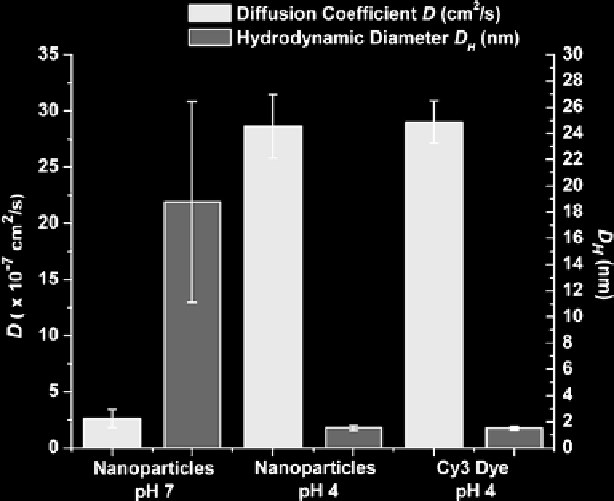Biomedical Engineering Reference
In-Depth Information
Fig. 4
Diffusion coefficient and hydrodynamic diameter of free Cy3 and Cy3-calcium phos-
phosilicate nanocomposite particles.
Diffusion coefficient (
black
) and the hydrodynamic diam-
eter (
gray
) of free Cy3 in Dulbecco's phosphate buffer solution (
DPBS
) at pH 4 and of Cy3
encapsulated calcium phosphosilicate nanoparticles at pH 4 and pH 7. No significant difference is
detected for
D
(
D
H
) between nanoparticles sample and free Cy3 at pH 4 verifying that the encap-
sulated Cy3 is released via dissolution form the calcium phosphosilicate nanoparticles (Reproduced
from Morgan (
2008
). With permission)
2.3
Significance of Colloidal Stability in Calcium
Phosphate Delivery Systems
The earliest study of calcium phosphate as a delivery vehicle was performed over
35 years ago with use as a gene transfection agent (Graham
1973
). These initial
nanoparticulate systems, though promising as a transfection agent, lacked colloidal
stability and size control. With the effect of colloidal stability and size becoming
increasingly significant in the intracellular delivery of nanoparticles and in
in vivo
applications, greater importance is being placed on these nanoparticulate
properties.
Lack of colloidal stability in a nanoparticulate system invariably leads to
agglomeration (Adair
2005
). Since size is a critical factor in cellular uptake, with
the optimal particle size ranging between 20 and 200 nm, avoiding agglomeration
is imperative (Gao
2005
; Chithrani
2006
; Thorek
2008
). Size also affects circula-
tion time, with larger particles easily trapped in the liver and rapidly removed from

Search WWH ::

Custom Search